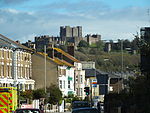Lydden Spout Battery
Artillery batteriesFortification stubsForts in Dover, KentMilitary history of Dover, KentUnited Kingdom military stubs ... and 2 more
Use British English from June 2017World War II stubs

Lydden Spout Battery is a World War II coastal defence battery built in 1941 west of Dover. Originally armed with three 6-inch Mark VII naval guns on Mark V mountings, later upgraded to Mark XXIV guns on the same mountings. Fan Bay Battery to the east of Dover is built to the same plan. The battery is to the south of the current A20. Most of the buildings have been demolished and the emplacements filled with concrete, but the catering rooms survive. Lydden Spout Battery's remaining buildings above ground: Warrant Officer's Mess/Sergeants Mess in the foreground. Dining room and cook house is the "L" shaped building behind.
Excerpt from the Wikipedia article Lydden Spout Battery (License: CC BY-SA 3.0, Authors, Images).Lydden Spout Battery
Old Folkestone Road,
Geographical coordinates (GPS) Address Nearby Places Show on map
Geographical coordinates (GPS)
| Latitude | Longitude |
|---|---|
| N 51.104 ° | E 1.26 ° |
Address
Old Folkestone Road
Old Folkestone Road
CT15 7AE , Hougham Without
England, United Kingdom
Open on Google Maps









